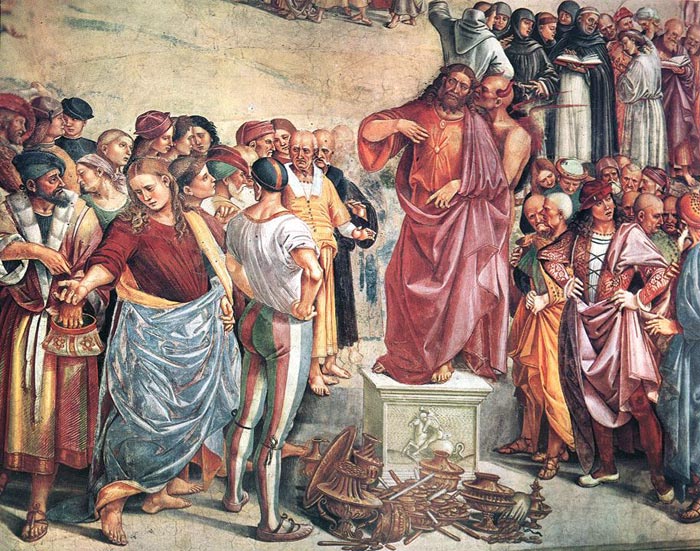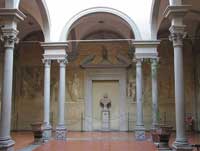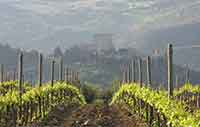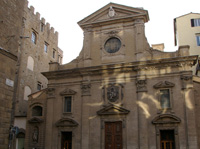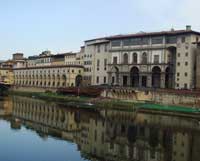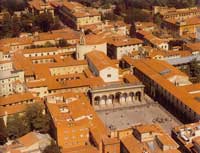| |
|
Girolamo Savonarola (21 September 1452, Ferrara, Emilia-Romagna – 23 May 1498, Florence) was an Italian Dominican friar and an influential contribution to the politics of Florence from 1494 until his execution in 1498.
Savonarola joined the Dominican order in 1475 and was sent to Florence to lecture at the convent of San Marco, where he became known for his learning and asceticism. His apocalyptic preaching maintained that the church needed reforming, that it would be scourged and then renewed. After the overthrow of the Medici family (1494), Savonarola became leader of Florence, setting up a democratic but severely puritanical government, notable for its "bonfire of the vanities," in which frivolous materials were burned. He also sought to establish a Christian republic as a base for reforming Italy and the church. He was opposed by the Arrabiati, supporters of the Medici, and by Pope Alexander VI, who attempted to restrain his unusual interpretations of scripture and his claim of prophecy. Savonarola was tried, convicted of heresy (1498), and hanged and burned in 1498.
On the day of his execution he was taken out to the Piazza della Signoria along with Fra Silvestro and Fra Domenico da Pescia. The three were ritually stripped of their clerical vestments, degraded as "heretics and schismatics", and given over to the secular authorities to be burned. The three were hanged in chains from a single cross and an enormous fire was lit beneath them. They were thereby executed in the same place where the "Bonfire of the Vanities" had been lit, and in the same manner that Savonarola had condemned other criminals himself during his own reign in Florence.
The painting above, depicting Savonarola's violent end, attributed to Francesco di Lorenzo Rosselli (from the Museo di San Marco in Florence, 1498), showing the pyre in front of the Palazzo Vecchio where he was killed.
|
|
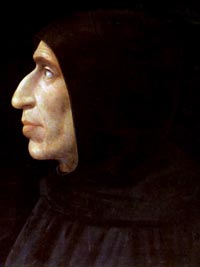 Fra Bartolomeo, Girolamo Savonarola, c. 1498, Florence, Museo di San Marco. |
| Early years
Savonarola was born in Ferrara, the capital of an independent Duchy in Emilia-Romagna, northern Italy. According to another source, he was born at Occhiobello, 7 km from Ferrara. He was born into a respected and affluent family that had originally resided in Padua.
In his youth he studied the Bible, St. Thomas Aquinas and Aristotle. Savonarola initially studied at the University of Ferrara, where he appears to have taken an advanced Arts degree. His stance against morally corrupt clergy was initially manifested in his poem on the destruction of the world entitled De Ruina Mundi (On the Downfall of the World), written at the age of 20. It was at this stage that he also began to develop his expression of moral conscience, and in 1475 his poem De Ruina Ecclesiae (On the Downfall of the Church) displayed his contempt for the Roman Curia by terming it 'a false, proud archaic wench'.
Friar Savonarola became a Dominican friar in 1475, during the Italian Renaissance, and entered the monastery of San Domenico in Bologna. He immersed himself in theological study, and in 1479 transferred to the monastery of Santa Maria degli Angeli. Finally in 1482 the Order dispatched him to Florence, the ‘city of his destiny’. Savonarola was lambasted for being ungainly, as well as being a poor orator. He made no impression on Florence in the 1480s, and his departure in 1487 went unnoticed. He returned to Bologna where he became 'master of studies’.
Savonarola returned to Florence in 1490 at the behest of Count Pico della Mirandola. There he began to preach passionately about the Last Days, accompanied by testimony about his visions and prophetic announcements of direct communications with God and the saints. Such fiery preaching was not uncommon at the time, but a series of circumstances quickly brought Savonarola great success. The first disaster to give credibility to Savonarola’s apocalyptic message was the Medici family's weakening grip on power owing to the French-Italian wars. The flowering of expensive Renaissance art and culture paid for by wealthy Italian families now seemed to mock the growing misery in Italy, creating a backlash of resentment among the people. The second disaster was the appearance of syphilis (or the “French pox”). Finally, the year 1500 was approaching, which may have brought about a mood of millennialism. In minds of many, the Last Days were impending and Savonarola was the prophet of the day.
His Church of San Marco was crowded to over-flowing during his celebration of Mass and at his sermons. Savonarola was a preacher, not a theologian. He preached that Christian life involved being good and practicing the virtues, rather than religious pomp and ceremony. He did not seek to make war on the Church of Rome. Rather, he wanted to correct the transgressions of worldly popes and secularized members of the Papal Curia.
Lorenzo de Medici, the previous ruler of Florence and patron of many Renaissance artists, was also a former patron of Savonarola. Eventually, Lorenzo and his son Piero de Medici became targets of Savonarola’s preaching.
Leader of Florence
After Charles VIII of France invaded Florence in 1494, the ruling Medici were overthrown and Savonarola emerged as the new leader of the city, combining in himself the role of secular leader and priest. He set up a republic in Florence. Characterizing it as a “Christian and religious Republic,” one of its first acts was to make sodomy, previously punishable by fine, into a capital offence. Homosexuality had previously been tolerated in the city, and many homosexuals from the elite now chose to leave Florence. His chief enemies were the Duke of Milan and Pope Alexander VI, who issued numerous restraints against him, all of which were ignored.
In 1497, he and his followers carried out the Bonfire of the Vanities. They sent boys from door to door collecting items associated with moral laxity: mirrors, cosmetics, lewd pictures, pagan books, immoral sculptures (which he wanted to be transformed into statues of the saints and modest depictions of biblical scenes), gaming tables, chess pieces, lutes and other musical instruments, fine dresses, women’s hats, and the works of immoral and ancient poets, and burnt them all in a large pile in the Piazza della Signoria of Florence.[2] Many fine Florentine Renaissance artworks were lost in Savonarola’s notorious bonfires — including paintings by Sandro Botticelli, which he is alleged to have thrown into the fires himself.
Florence soon became tired of Savonarola because of the city’s continual political and economic miseries partially derived from Savonarola's opposition to trading and making money. When a Franciscan preacher challenged him to a trial by fire in the city centre and he declined, his following began to dissipate.
During his Ascension Day sermon on May 4, 1497, bands of youths rioted, and the riot became a revolt: dancing and singing taverns reopened, and men again dared to gamble publicly.
Excommunication and execution On May 13, 1497, the rigorous Father Savonarola was excommunicated by Pope Alexander VI, and in 1498, Alexander demanded his arrest and execution. On April 8, a crowd attacked the Convent of San Marco. A bloody struggle ensued, during which several of Savonarola’s guards and religious supporters were killed. Savonarola surrendered along with Fra Domenico da Pescia and Fra Silvestro, his two closest associates. Savonarola was faced with charges such as heresy, uttering prophecies, sedition, and other crimes, called religious errors by the Borgia pope.
During the next few weeks all three were tortured on the rack, the torturers sparing only Savonarola’s right arm in order that he might be able to sign his confession. All three signed confessions, Savonarola doing so sometime prior to May 8. On that day he completed a written meditation on the Miserere mei, Psalm 50, entitled Infelix ego, in which he pleaded with God for mercy for his physical weakness in confessing to crimes he believed he did not commit. On the day of his execution, May 23, 1498, he was still working on another meditation, this one on Psalm 31, entitled Tristitia obsedit me.
On the day of his execution he was taken out to the Piazza della Signoria along with Fra Silvestro and Fra Domenico da Pescia. The three were ritually stripped of their clerical vestments, degraded as "heretics and schismatics", and given over to the secular authorities to be burned. The three were hanged in chains from a single cross and an enormous fire was lit beneath them. They were thereby executed in the same place where the "Bonfire of the Vanities" had been lit, and in the same manner that Savonarola had condemned other criminals himself during his own reign in Florence. Jacopo Nardi, who recorded the incident in his Istorie della città di Firenze, wrote that his executioner lit the flame exclaiming, “The one who wanted to burn me is now himself put to the flames.” Luca Landucci, who was present, wrote in his diary that the burning took several hours, and that the remains were several times broken apart and mixed with brushwood so that not the slightest piece could be later recovered, as the ecclesiastical authorities did not want Savonarola’s followers to have any relics for a future generation of the rigorist preacher they considered a saint. The ashes of the three were afterwards thrown in the Arno beside the Ponte Vecchio.
Niccolò Machiavelli, author of The Prince, also witnessed and wrote about the execution. Subsequently, Florence was governed along more traditional republican lines, until the return of the Medici in 1512.
|
| |
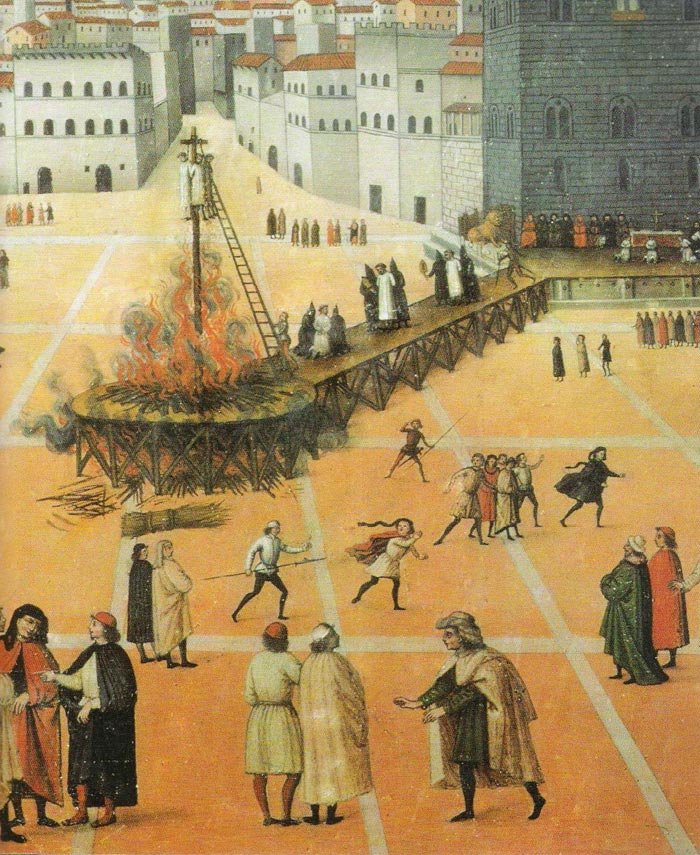 |
Francesco di Lorenzo Rosselli, Execution of Girolamo Savonarola in Piazza della Signoria in Florence in 1498 (detail), Museo di San Marco, Florence. |
Character and influence
Savonarola's religious actions have been compared to those of the later 17th and 18th century Jansenists, although theologically many differences exist. Savonarola did not produce a theological doctrine on salvation, and faithfully adhered to even minor theological definitions of the papal Magisterium. However, Savonarola's call to simplicity in church interior and his rigorous moral stances have been compared to those of Jansenists. Also the insistence on the immediate danger of Hell and the fewness of the elect can be considered to be a similarity.
After Savonarola's death, a secret Catholic group known as the Piagnoni sprang up in Florence to preserve his memory, organized into a sort of Catholic guild. Franciscan friars were prominent among the Piagnoni, and they briefly re-appeared in 1527 when they once again overthrew the Medici, but through intervention of the Holy Roman Empire it was brought to an end in 1530 at the Battle of Gavinana and the Medici were restored to power.
Savonarola left many admirers throughout Europe, in particular among religiously pious humanists who valued his deep spiritual convictions. Erasmus, who refused to become a Protestant, is said to have remained Catholic due to reading Savonarola. At the same time, he is considered by Protestants to be a forerunner of the Reformation because of his criticisms of the papacy. Savonarola was said to be an inspiration to Michelangelo and Martin Luther.
In the twentieth century, a movement for the canonization of Frà Savonarola began to develop within the Roman Catholic Church, particularly among Dominicans, with many judging his excommunication and execution to have been unjust. His potential beatification and canonization is opposed by many Jesuits, who consider Savonarola's (secular) conflict with the papacy to have been an intolerable crime.
The ideas of Savonarola in Sandro Botticelli's 'The Mystical Nativity'
The painting ‘Mystic Nativity’, by Sandro Botticelli, about 1500- 1510, is preserved since 1878 in the National Gallery, London. Experts mean that the ideas of Savonarola are illustrated in ‘The Mystical Nativity’, circa 1500-1501. The board of the National Gallery wrote:
‘The Florentine artist Sandro Botticelli painted the 'Mystic Nativity', dated 1500, at the turn of the half-millennium. At first glance the painting seems to show a conventional Nativity scene. Shepherds and wise men have come to visit the new-born king, while angels in the heavens dance and sing hymns of praise. However, the text at the top of the picture, veiled in scholarly Greek, provides a key to further layers of meaning.
|
However, There is no documentary evidence to prove whether or not Botticelli was one of Savonarola's follower. But certain themes in his later works - like the Mystic Nativity - are certainly derived from the sermons of Savonarola, which means that the artist was definitely attracted by that personality so central to the cultural and political events of Florence during the last years of the fifteenth century.
It has been suggested that this picture, the only surviving work signed by Botticelli, was painted for his own private devotions, or for someone close to him. It is certainly unconventional, and does not simply represent the traditional events of the birth of Jesus and the adoration of the shepherds and the Magi or Wise Men. Rather it is a vision of these events inspired by the prophecies in the Revelation of Saint John. Botticelli has underlined the non-realism of the picture by including Latin and Greek texts, and by adopting the conventions of medieval art, such as discrepancies in scale, for symbolic ends.
The puzzling Greek inscription at the top of the picture has been translated: 'I Sandro made this picture at the conclusion of the year 1500 in the troubles of Italy in the half time after the time according to the 11th chapter of Saint John in the second woe of the Apocalypse during the loosing of the devil for three and a half years then he will be chained in the 12th chapter and we shall see [...] as in this picture.'
The Mystical Nativity depicts a scene of joy and celebration, of earthly and heavenly delight, with angels dancing at the top of the painting. At the top of the painting Sandro Botticelli's name - but also the apocalyptic and troubling words. And there are dark premonitions - the helpless child rests on a sheet that evokes the shroud in which his body will one day be wrapped, while the cave in which the scene is set calls to mind his tomb. The Kings on the left bear no gifts, but their own devotion. At the top of the painting twelve angels dressed in the colours of faith, hope and charity dance in a circle holding olive branches, and above them heaven opens in a great golden dome, while at the bottom of the painting three angels embrace three men, seeming to raise them up from the ground. They hold scrolls which proclaim in Latin, peace on earth to men of goodwill. Behind them seven devils flee to the underworld, some impaled on their own weapons.
Art in Tuscany | Sandro Botticelli's 'The Mystical Nativity'
|
|
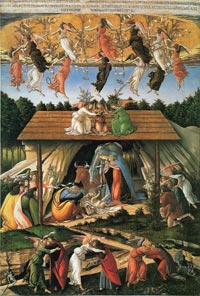 Sandro Botticelli, Mystical Nativity, London, National Gallery Sandro Botticelli, Mystical Nativity, London, National Gallery
|
The ideas of Savonarola in Luca Signorelli's 'Sermon and Deeds of the Antichrist'
|
|
|
Luca Signorelli, on 5 April 1499, signed a contract with Orvieto Cathedral. He was to paint the two remaining sections of the ceiling of the Chapel of San Brizio, a large Gothic construction built around 1408. These frescoes in the chapel are considered the most complex and impressive work by Signorelli. He and his school spent two years creating a series of frescoes concerning the Apocalypse and the Last Judgment, starting with the Preaching of the Antichrist, continuing with tumultuous episodes of the End of the World, finding a counterpart in the Resurrection of the Flesh. The fourth scene is a frightening depiction of the Damned are taken to Hell and received by Demons. On the wall behind the altar, Signorelli depicts on the left side the Elect being led to Paradise and on the right side the Reprobates driven to Hell. He added to these expressive scenes some striking details.
Luca Signorelli's The Preaching of the Antichrist was painted shortly after the execution of Savonarola in Florence on 23 May 1498. This friar had been judged guilty of heresy. And so is the Antichrist, preaching slander and calumny, causing an uproar such as Savonarola did. The Antichrist is depicted resembling Christ, but is embraced by the Devil whispering in his ear. Among the crowd listening to the Antichrist Signorelli has painted some remarkable figures: a young Raphael in a striking pose, Dante, possibly Christopher Columbus, Boccaccio, Petrarch and Cesare Borgia. Remarkably, in the left corner of the fresco, he has painted himself, dressed in noble garments, and Fra Angelico in habit. In the left background the Antichrist is being chased from heavens by the archangel Michael, and his acolytes being killed by a rain of fire. In the right background he depicts a large Classical temple topped by a dome in Renaissance style. More likely is that the scenes reflect scripture readings called for in the liturgies for the Feast of All Saints and the four Sundays of Advent.
|
|
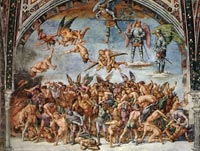 |
|
Luca Signorelli, Sermon and Deeds of the Antichrist (detail), 1499-1502, fresco, Chapel of San Brizio, Duomo, Orvieto
|
|
|
|
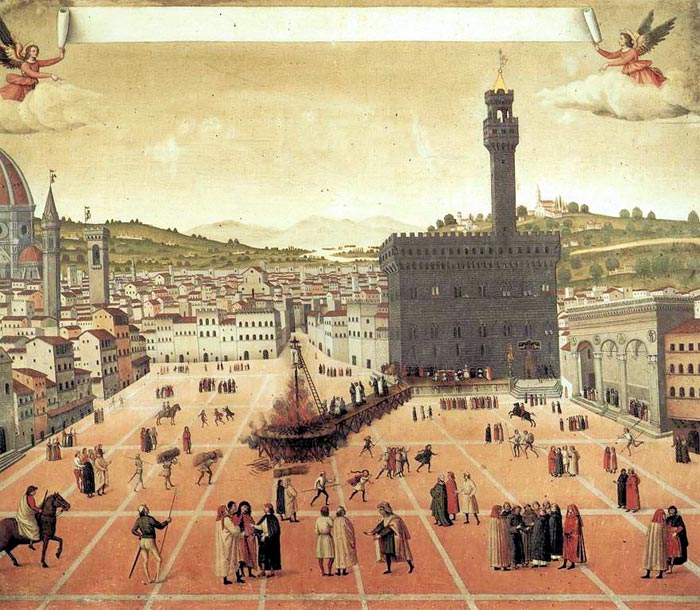
 Fra Bartolomeo, Girolamo Savonarola, c. 1498, Florence, Museo di San Marco.
Fra Bartolomeo, Girolamo Savonarola, c. 1498, Florence, Museo di San Marco. 

